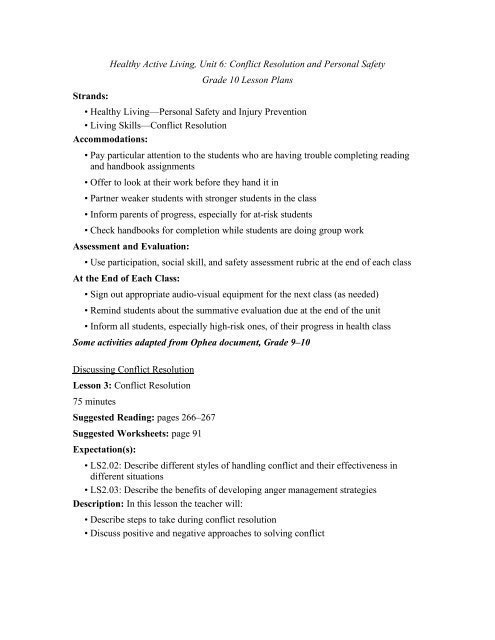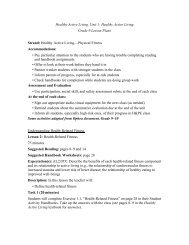Conflict Resolution and Personal Safety Grade 10 Lesson Plans ...
Conflict Resolution and Personal Safety Grade 10 Lesson Plans ...
Conflict Resolution and Personal Safety Grade 10 Lesson Plans ...
You also want an ePaper? Increase the reach of your titles
YUMPU automatically turns print PDFs into web optimized ePapers that Google loves.
Str<strong>and</strong>s:<br />
Healthy Active Living, Unit 6: <strong>Conflict</strong> <strong>Resolution</strong> <strong>and</strong> <strong>Personal</strong> <strong>Safety</strong><br />
<strong>Grade</strong> <strong>10</strong> <strong>Lesson</strong> <strong>Plans</strong><br />
• Healthy Living—<strong>Personal</strong> <strong>Safety</strong> <strong>and</strong> Injury Prevention<br />
• Living Skills—<strong>Conflict</strong> <strong>Resolution</strong><br />
Accommodations:<br />
• Pay particular attention to the students who are having trouble completing reading<br />
<strong>and</strong> h<strong>and</strong>book assignments<br />
• Offer to look at their work before they h<strong>and</strong> it in<br />
• Partner weaker students with stronger students in the class<br />
• Inform parents of progress, especially for at-risk students<br />
• Check h<strong>and</strong>books for completion while students are doing group work<br />
Assessment <strong>and</strong> Evaluation:<br />
• Use participation, social skill, <strong>and</strong> safety assessment rubric at the end of each class<br />
At the End of Each Class:<br />
• Sign out appropriate audio-visual equipment for the next class (as needed)<br />
• Remind students about the summative evaluation due at the end of the unit<br />
• Inform all students, especially high-risk ones, of their progress in health class<br />
Some activities adapted from Ophea document, <strong>Grade</strong> 9–<strong>10</strong><br />
Discussing <strong>Conflict</strong> <strong>Resolution</strong><br />
<strong>Lesson</strong> 3: <strong>Conflict</strong> <strong>Resolution</strong><br />
75 minutes<br />
Suggested Reading: pages 266–267<br />
Suggested Worksheets: page 91<br />
Expectation(s):<br />
• LS2.02: Describe different styles of h<strong>and</strong>ling conflict <strong>and</strong> their effectiveness in<br />
different situations<br />
• LS2.03: Describe the benefits of developing anger management strategies<br />
Description: In this lesson the teacher will:<br />
• Describe steps to take during conflict resolution<br />
• Discuss positive <strong>and</strong> negative approaches to solving conflict
Task 1 (15 minutes)<br />
Outline the steps to take during conflict resolution:<br />
1. State the problem.<br />
o Don’t place blame or accuse<br />
2. Define the scope of the problem.<br />
o Identify areas of agreement <strong>and</strong> areas of disagreement<br />
3. Brainstorm possible solutions.<br />
o List as many solutions as possible<br />
4. Identify the consequences of each solution.<br />
o List the pros <strong>and</strong> cons for each proposed solution<br />
5. Choose a solution on which both parties can agree.<br />
Emphasize that while conflict resolution is tough, it is possible to have a constructive<br />
argument that ends in both parties being satisfied with the resolution, which is a win-win<br />
situation for everyone concerned.<br />
Task 2 (60 minutes)<br />
Alone or in pairs, students will complete Exercise 6.3, “Solving <strong>Conflict</strong>s” on page 91 of<br />
their Student Activity H<strong>and</strong>book. Each person (or pair) will create a scenario that<br />
involves two individuals in a conflict situation—in school or in the community at large—<br />
<strong>and</strong> will complete the steps as identified on the worksheet to find a solution that is the<br />
most acceptable to each party in the disagreement. If there is not enough room on the<br />
worksheet, students may write their scenario, areas of agreement <strong>and</strong> disagreement,<br />
possible solutions, <strong>and</strong> outcome on a separate piece of paper.<br />
When the class has finished, ask for volunteers to present their scenario <strong>and</strong> solution to<br />
their peers. Invite the rest of the class to offer their (constructive) opinions on what they<br />
might have suggested as an alternate solution to the one that has been proposed. If<br />
another student has thought of an unforeseen consequence to the presented solution, ask<br />
the presenter if he or she would choose a different solution given this new information.<br />
For Next Class:<br />
• Students should read pages 270–271 in their Healthy Active Living textbook

















